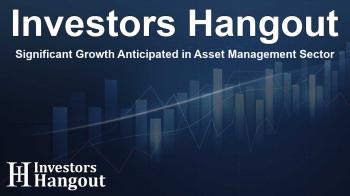Significant Growth Anticipated in Asset Management Sector

The Dynamic Growth of the Enterprise Asset Management Market
The enterprise asset management (EAM) market is on the brink of profound growth as organizations increasingly seek ways to enhance the lifespan of their assets and maximize returns on investment. EAM systems are vital as they provide organizations the tools needed for tracking, maintaining, and analyzing their physical assets from acquisition to disposal.
Market Growth Projections and Influential Factors
Recent forecasts indicate that the enterprise asset management market is projected to grow substantially, indicating a robust CAGR driven by the shift towards digital transformation. With an anticipated reach of over USD 187 Billion, the market is expected to thrive as industries integrate advanced technologies such as the Internet of Things (IoT), Artificial Intelligence (AI), and predictive analytics. This transition fosters real-time monitoring of assets, automates maintenance schedules, and forecasts performance, thereby promoting operational efficiency and proactive asset management strategies.
Driving Forces Behind EAM Growth
A significant contributor to the market expansion is the increasing pressure from industries like energy, manufacturing, and utilities, which depend heavily on extensive physical infrastructure. Companies are compelled to manage aging assets and control operational costs, leading to a surge in EAM system adoption. These systems provide real-time data insights, which help organizations in making informed decisions and minimizing disruptions to critical operations.
Technological Advancements and Their Impact
Innovations within the enterprise asset management sector have been transformative. For instance, a major player has recently introduced an EAM platform that employs built-in AI for enhancing operational efficiency and decision-making. Such developments underscore the industry’s shift towards leveraging data-driven insights to automate diagnostics and proactive maintenance scheduling.
Challenges in EAM Implementation
Despite the advantages, the implementation of comprehensive EAM solutions isn't without challenges. Organizations face significant hurdles such as long rollout times, which can take months or even years, disrupting business continuity and straining resources. Additionally, achieving seamless integration with existing enterprise applications poses a challenge due to differing data standards and technologies.
Addressing Integration Issues
The integration of EAM systems with other applications such as Enterprise Resource Planning (ERP), Supply Chain Management (SCM), and Customer Relationship Management (CRM) can be complex. These compatibility issues not only increase costs but may also deter enterprises from adopting integrated solutions essential for maximizing EAM benefits.
Competitive Landscape in the EAM Market
The enterprise asset management landscape is characterized by intense competition, with leading players such as IBM, SAP, Oracle, and Siemens driving innovation and development. Each of these companies adopts unique strategies to expand their market reach, including technological partnerships, acquisitions, and continuous platform upgrades.
Market Segmentation Insights
The enterprise asset management market is fundamentally segmented into offerings, applications, deployment modes, and geographical regions. This segmentation allows for a nuanced understanding of market trends and consumer needs. For instance, solutions dominate the offerings due to the high demand for automation, with asset lifecycle management being a pivotal application focusing on managing assets throughout their lifespan and optimizing maintenance.
Regional Insights and Growth Opportunities
Globally, North America is a front-runner in the enterprise asset management market, attributed to the early adoption of technologies and a strong vendor presence. Meanwhile, the Asia Pacific region is experiencing accelerated growth fueled by industrial development and infrastructure expansion. Countries such as China and India are making significant strides in adopting EAM solutions to improve asset management processes.
Conclusion: Future of Enterprise Asset Management
Looking ahead, the enterprise asset management market is expected to flourish further, driven by technological advancements and the ever-evolving demands of industries seeking efficiency and sustainability. As organizations continue to prioritize smart asset management strategies, the role of EAM systems becomes increasingly crucial in achieving operational excellence.
Frequently Asked Questions
What is the enterprise asset management market?
The enterprise asset management market involves systems and software that help organizations manage their physical assets efficiently across their lifecycles.
How is the enterprise asset management market growing?
The market is growing due to increased digital transformation, the need for compliance, and the demand for enhanced efficiency in managing physical assets.
What are key technologies in EAM?
Key technologies include IoT, AI, and predictive analytics, which facilitate real-time monitoring and proactive maintenance of assets.
What challenges does the EAM market face?
Challenges include integration complexities, high implementation times, and the need for significant investment in technology infrastructure.
Who are the major players in the EAM market?
Major players include IBM, SAP, Oracle, Siemens, and others, who are all focused on creating innovative solutions to address market demands.
About The Author
Contact Evelyn Baker privately here. Or send an email with ATTN: Evelyn Baker as the subject to contact@investorshangout.com.
About Investors Hangout
Investors Hangout is a leading online stock forum for financial discussion and learning, offering a wide range of free tools and resources. It draws in traders of all levels, who exchange market knowledge, investigate trading tactics, and keep an eye on industry developments in real time. Featuring financial articles, stock message boards, quotes, charts, company profiles, and live news updates. Through cooperative learning and a wealth of informational resources, it helps users from novices creating their first portfolios to experts honing their techniques. Join Investors Hangout today: https://investorshangout.com/
The content of this article is based on factual, publicly available information and does not represent legal, financial, or investment advice. Investors Hangout does not offer financial advice, and the author is not a licensed financial advisor. Consult a qualified advisor before making any financial or investment decisions based on this article. This article should not be considered advice to purchase, sell, or hold any securities or other investments. If any of the material provided here is inaccurate, please contact us for corrections.

